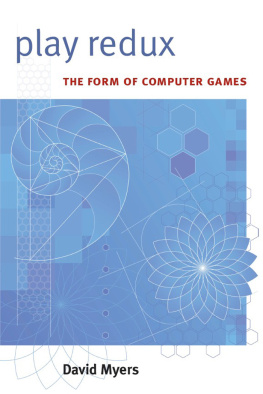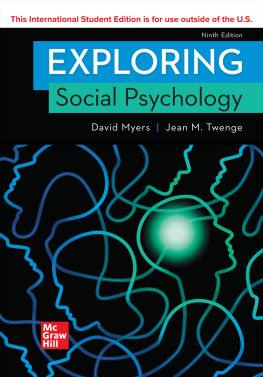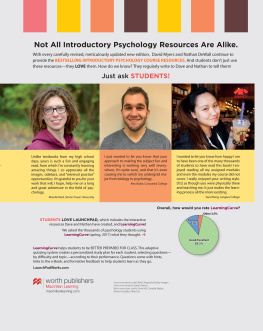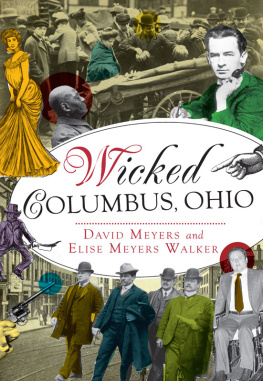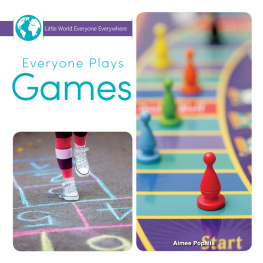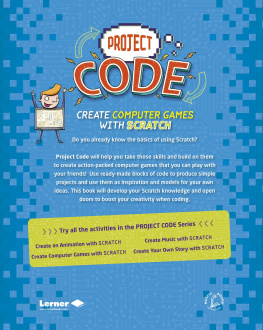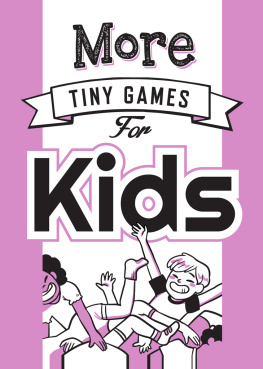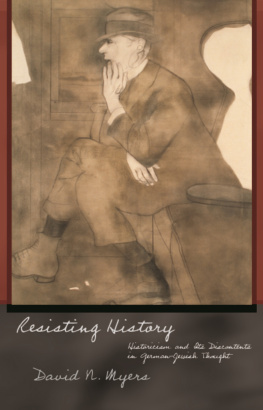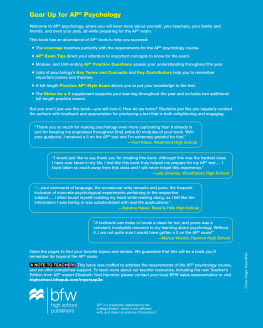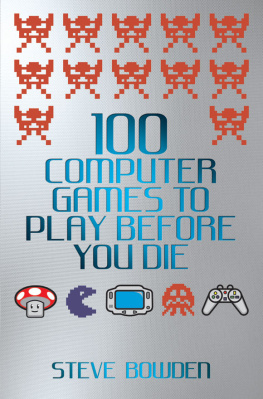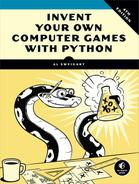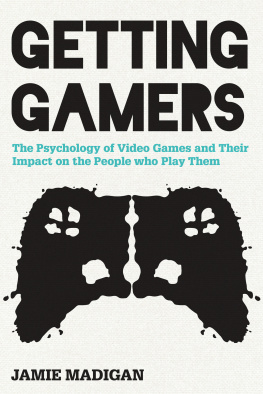David Myers - Play Redux: THE FORM OF COMPUTER GAMES
Here you can read online David Myers - Play Redux: THE FORM OF COMPUTER GAMES full text of the book (entire story) in english for free. Download pdf and epub, get meaning, cover and reviews about this ebook. year: 2018, publisher: The University of Michigan Press, genre: Children. Description of the work, (preface) as well as reviews are available. Best literature library LitArk.com created for fans of good reading and offers a wide selection of genres:
Romance novel
Science fiction
Adventure
Detective
Science
History
Home and family
Prose
Art
Politics
Computer
Non-fiction
Religion
Business
Children
Humor
Choose a favorite category and find really read worthwhile books. Enjoy immersion in the world of imagination, feel the emotions of the characters or learn something new for yourself, make an fascinating discovery.
- Book:Play Redux: THE FORM OF COMPUTER GAMES
- Author:
- Publisher:The University of Michigan Press
- Genre:
- Year:2018
- Rating:5 / 5
- Favourites:Add to favourites
- Your mark:
- 100
- 1
- 2
- 3
- 4
- 5
Play Redux: THE FORM OF COMPUTER GAMES: summary, description and annotation
We offer to read an annotation, description, summary or preface (depends on what the author of the book "Play Redux: THE FORM OF COMPUTER GAMES" wrote himself). If you haven't found the necessary information about the book — write in the comments, we will try to find it.
Play Redux: THE FORM OF COMPUTER GAMES — read online for free the complete book (whole text) full work
Below is the text of the book, divided by pages. System saving the place of the last page read, allows you to conveniently read the book "Play Redux: THE FORM OF COMPUTER GAMES" online for free, without having to search again every time where you left off. Put a bookmark, and you can go to the page where you finished reading at any time.
Font size:
Interval:
Bookmark:
- What computer games are
- What computer games arent
- The self and the social
- The genie in the bottle
 Page i
Page i PLAY REDUX
Page iiDIGITALCULTUREBOOKS is an imprint of the University of Michigan Press and the Scholarly Publishing Office of the University of Michigan Library dedicated to publishing innovative and accessible work exploring new media and their impact on society, culture, and scholarly communication.
Page iiiTHE FORM OF COMPUTER GAMES
David Myers
THE UNIVERSITY OF MICHIGAN PRESS AND
THE UNIVERSITY OF MICHIGAN LIBRARY
Ann Arbor
Copyright by the University of Michigan 2010
All rights reserved
Published in the United States of America by
The University of Michigan Press and
The University of Michigan Library
Manufactured in the United States of America Printed on acid-free paper
Printed on acid-free paper
2013 2012 2011 2010 4 3 2 1
No part of this publication may be reproduced, stored in a retrieval system, or transmitted in any form or by any means, electronic, mechanical, or otherwise, without the written permission of the publisher.
A CIP catalog record for this book is available from the British Library.
Library of Congress Cataloging-in-Publication Data
Myers, David.
Play redux : the form of computer games / David Myers.
p. cm.
Includes bibliographical references and index.
ISBN 978-0-472-07092-3 (cloth : alk. paper) ISBN 978-0-472-05092-5 (pbk. : alk. paper)
1. Computer gamesSocial aspects. 2. PlaySocial aspects.
I. Title.
GV 1469.17.s63M95 2010
794.8dc22
2009038405
ISBN13 978-0-472-02687-6 (electronic)
Page vGod bless everyone.
Mother and Daddy.
Nanee and GeeGee.
Grandma and Grandpa.
Kim.
Me.
Megan and Sarah.
Susan.
And all the rest.
Play ball.
- What computer games are
- What computer games arent
- The self and the social
- The genie in the bottle
Play is a very interesting thing. Somewhat strangely, though, play is not studied as often as are the consequences of play.
The reason for this becomes clear when we try to study play: it is a very hard thing to study. Play resists our scrutiny in characteristically slippery ways. One of these is the degree to which play is dependent on and determined by paradox. In The Nature of Computer Games (2003), I spent a great deal of time focusing on the paradoxical nature of play. In that book, I classified paradoxes according to commonly accepted categories, examined common features of those categories, and concluded that paradoxesand most particularly play-related paradoxesare a form of self-reference.
Prototypical examples of self-referential paradoxes are these:
- The Liars Paradox: This statement is false.
- Russells Paradox: The set of all sets that are not members of themselves.
In the Liars Paradox, the statement refers to itself directly; in Russells Paradox, the set refers to itself by including itself in its own membership. The result, in both cases, is that we have trouble understanding what these paradoxes mean. When we try to derive a meaning from the Liars Paradox, for instance, we find our meaning-making process oscillating between thinking the statement is true (which it must be in order to be false) and thinking the statement is false (because, after all, that is what the statement says it is).
This oscillation of meaning doesnt stop. And because we find ourselves (potentially forever) in the midst of this oscillation, befuddled, our awareness and attention turn from the meaning we cannot derive to the meaning-making process that cannot derive it. That is, we turn our awareness and Page 2 attention from the content of meaning to the form of meaning (and/or the lack thereof).
In this brief analysis, then, are a couple of important realizations concerning the nature and study of play that I wish to pursue further here. First and foremost, play involves a special form of self-reference. And because play exhibits a particular self-referential formsimilar to paradoxthe study of play offers opportunities for formalist methods of study. Second, a self-referential form is also, obviously and importantly, referential. Therefore, the study of play should involve not only the study of self-referential forms but also the study of references and referencing in general: that is, semiosis.
Currently and curiously, the study of play does not often focus on either its formal properties or its semiotic properties as much as it focuses on other things. The most prominent and frequent of these other things is culture.
In the 1970s, which was quite some time ago it seems, I was an undergraduate English major at Yale University. Walking across campus on some dark and snowy eve, a fellow student pointed out to me a bearish figure receding in the distance, coated and capped, who was, I was told, William K. Wimsatt, the formalist.
After a long career in academia, Wimsatt died in 1975; his primary teaching duties at Yale had been curtailedif not completed entirelysometime before that. Thus, I am uncertain whether this figure in memory was Wimsatt indeed or simply one relatively naive students wild speculation to another. In any case, that particular image has stuck in my mind as emblematic of the decline of formalists and formalism, both of which were, by the mid-1970s, being shunted into obscurity.
During the mid-twentieth century and beyond, formalist models of literature were superseded by structuralist models of history and, subsequently buoyed by post-structuralism, cultural studies. In this supersession, cultural studies relegated the study of language and literatureand aesthetics in generalto a subset of its own broader, more inclusive, and often impenetrably complex view of social relationships as instrumental and unavoidable in determining human thoughts, interpretations, and meanings.
Ostensibly, semiotics is the study of semiosis, or the human meaning-making process. However, in common practice, semiotics as an academic discipline has tended to adopt a particular set of assumptions regarding how and under what influences a human-like meaning-making process operates. These assumptions are, by and large, equivalent to those of cultural studies. Thus, conventional semiotic analysis situates the human meaning-making process in a particular cultural context.
Page 3 This is contrary to the assumptions I am going to bring to bear here, and it is contrary to the original assumptions of formalism as held and promoted by William K. Wimsatt, Cleanth Brooks, Viktor Shklovsky, and other similar formalists.
Wimsatt and Beardsley (1954) coined the terms intentional fallacy and affective fallacy to emphasize exactly this issue. The tenets of their New Criticism claimed that it is the literary work itselfits interior mechanicsthat determine its value as literature, or its literariness. If you were, rather, to determine that literariness on the basis of author intentincluding author history, culture, or psychologythen you would be guilty of an intentional fallacy. Likewise, if you were, rather, to determine that literariness on the basis of audience (reader) responseemotive or otherwiseyou would suffer from an affective fallacy.
Above all other things, it is this claim that sets formalism apart from its opposition: the formal properties of an artwork are its defining properties.
Next pageFont size:
Interval:
Bookmark:
Similar books «Play Redux: THE FORM OF COMPUTER GAMES»
Look at similar books to Play Redux: THE FORM OF COMPUTER GAMES. We have selected literature similar in name and meaning in the hope of providing readers with more options to find new, interesting, not yet read works.
Discussion, reviews of the book Play Redux: THE FORM OF COMPUTER GAMES and just readers' own opinions. Leave your comments, write what you think about the work, its meaning or the main characters. Specify what exactly you liked and what you didn't like, and why you think so.

